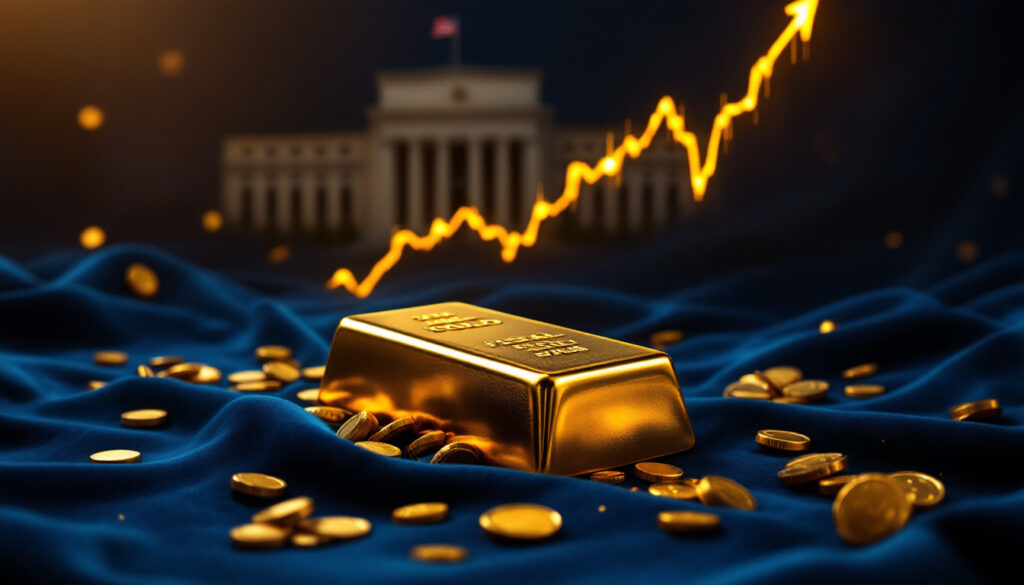Gold Price Hits New Record as Fed Holds Rates Steady: Market Analysis & Impact
Gold has reached unprecedented heights, recently surging to a record high of $3,045 per ounce following the Federal Reserve's decision to maintain current interest rates. This remarkable 12.5% year-to-date increase comes amid persistent economic uncertainty and significant policy shifts that have created ideal conditions for precious metals appreciation.
The milestone represents more than just a number—it signals profound shifts in global investment strategies as both institutional and retail investors recalibrate their portfolios in response to evolving monetary policy and geopolitical tensions.
The Federal Reserve's March 2025 Decision
The Fed maintained its benchmark interest rate range at 4.25% to 4.50% during its March 18-19 meeting, marking no change since the November 2024 adjustment. This "higher for longer" stance contrasts with earlier market expectations, creating a balancing act between short-term dollar strength and longer-term stagflation concerns.
Perhaps more significant was the central bank's announcement to slow its balance sheet reduction from $95 billion to $60 billion per month, signaling a more cautious approach to liquidity management that has helped fuel gold's rise.
As Federal Reserve Chair Jerome Powell stated during the press conference: "Inflation remains somewhat elevated but is progressing toward our 2% target." This careful phrasing reflects the delicate balance the Fed is trying to maintain.
Current Economic Indicators Influencing Gold
- Inflation Data: US Consumer Price Index (CPI) registered at 2.8% year-on-year in February 2025, down slightly from 3.0% in January, but still above the Fed's target
- Personal Consumption Expenditures: The PCE price index (the Fed's preferred inflation gauge) showed a 2.5% year-on-year increase in January, compared to 2.6% in December
- Employment Conditions: Labor market rebalancing continues with JOLTS job openings at 8.1 million (down from 10 million in 2023), while unemployment remains near 50-year lows at 3.8%
- Treasury Yields: The 10-year Treasury yield stands at 3.8%, maintaining an inverse relationship with gold prices
- Real Yields: 10-year TIPS yield at -1.2%, enhancing gold's appeal as a non-yielding asset
According to the World Gold Council's Q1 2025 report, central banks purchased 228 metric tons of gold in the first quarter alone, providing substantial price support and reflecting ongoing concerns about dollar dominance.
Why Are Gold Prices Reaching Record Highs in 2025?
The perfect storm of economic conditions has propelled gold to unprecedented heights, with multiple factors converging to drive investor demand:
Global Uncertainty and Risk Factors
The Geopolitical Risk Index (GPR) currently stands at 185 (compared to the 2024 average of 150), driven primarily by escalating U.S.-China trade tensions and persistent Middle East conflicts. This heightened level of uncertainty has historically correlated strongly with gold prices analysis.
David Rosenberg, noted economist and founder of Rosenberg Research, explains: "Gold's rally reflects a 'de-dollarization' trend, with BRICS nations increasingly allocating reserves away from traditional currencies and toward precious metals."
Monetary Policy Expectations
Despite maintaining current rates, the Fed continues to project two interest rate cuts for 2025. This forward guidance has contributed significantly to gold's appeal, as markets typically price in future policy shifts before they occur.
JP Morgan's 2025 Commodities Outlook forecasts gold to average $3,200 per ounce in the second half of 2025, noting: "The anticipated rate cut cycle, combined with the Fed's slowing balance sheet reduction, creates an environment where real yields will likely remain negative, supporting non-yielding assets like gold."
Institutional and Retail Demand
Global ETF gold holdings have increased 7% year-to-date to 3,450 metric tons, reversing the outflows seen in previous years. This shift in investor sentiment has been particularly pronounced in:
- Asian markets, with Shanghai Gold Exchange volumes up 15%
- European funds seeking inflation protection amid ECB policy shifts
- U.S. retirement accounts increasing alternative asset allocations
Additionally, the U.S. debt-to-GDP ratio now stands at 135%, creating structural inflation concerns that further enhance gold's traditional role as a safe haven.
How Does the Trump Administration's Policy Affect Gold Prices?
The current administration's policy direction has introduced significant market volatility, creating both challenges and opportunities for gold investors.
Trump's Tariff Policies and Economic Uncertainty
Chair Powell specifically highlighted four key areas of policy change creating uncertainty in the economic outlook:
- Trade policies and tariff implementations
- Immigration reforms affecting labor markets
- Fiscal policy adjustments, including tax structures
- Regulatory changes across multiple sectors
These factors have collectively contributed to market apprehension, with the Peterson Institute for International Economics estimating that "full Trump tariff rollout could add 1.2% to CPI by 2026."
Potential Inflationary Impact of Tariffs
The implementation of new tariffs could substantially impact consumer prices across critical sectors:
| Product Category | Potential Price Impact | Reason |
|---|---|---|
| Gasoline | $0.30/gallon increase | 10% oil import tariffs from Canada |
| New homes | $5,000 higher costs | 15% lumber import tariffs |
| Automobiles | $2,000+ price inflation | Steel and aluminum import restrictions |
Larry Kudlow, former Trump economic adviser, has noted: "Tariffs aim to reshore industries but risk short-term inflationary spikes." This dynamic creates a complicated scenario where policy-induced inflation could benefit gold while potentially slowing economic growth.
Historical Precedent: 2018-2019 Tariff Impact
During the previous Trump administration, steel tariffs raised auto prices by approximately $2,000 per vehicle, according to Bureau of Economic Analysis data from 2019. This period saw gold prices begin a sustained rally that continued into 2020, suggesting similar policies could support the current gold price forecast.
The impact channels for tariffs operate through: (1) direct import costs, (2) supply chain bottlenecks, and (3) retaliatory measures from trading partners, all of which can create inflationary pressures that historically benefit gold prices.
What Did Jerome Powell Say About Economic Outlook?
During his post-meeting remarks, Powell offered several key insights into the Fed's thinking that provide crucial context for gold investors.
Powell's Key Statements on Policy Direction
Powell emphasized the Fed's commitment to its dual mandate of maximum employment and price stability. The central bank's current projections include:
- 2025 GDP growth forecast of 1.9% (down from 2.4% in 2024)
- Core PCE inflation projection of 2.6% (still above the 2% target)
- Unemployment rate stabilizing around 3.8%
"I would tell people that the economy seems to be healthy; we understand that sentiment seems to be quite negative at this time, and that probably has to do with turmoil at the beginning of an administration," Powell stated, acknowledging the disconnect between economic data and public perception.
The Fed's Approach to Uncertainty
Powell stressed the importance of "separating the signal from the noise" amid the current economic climate, noting that the Fed is:
- Focusing on data-driven decision-making rather than political considerations
- Waiting for greater clarity before making significant policy changes
- Maintaining a position of readiness to adjust as conditions evolve
This cautious approach parallels the pre-Great Financial Crisis period of 2006-2007, when rate holds preceded a substantial gold rally amid growing economic concerns.
Rate Cut Projections for 2025
Despite maintaining current rates, Fed Funds futures data shows a 73% probability of a September 2025 rate cut. This expectation is creating a unique environment where gold benefits from both current higher rates (elevating inflation concerns) and anticipated future cuts (reducing opportunity costs).
Treasury Secretary Janet Yellen added context, noting that "Fed's cautious stance aligns with sustainable wage growth," currently at 4.3% year-over-year.
How Did Markets React to the Fed's Decision?
The Fed's announcement triggered significant movements across multiple asset classes, with precious metals showing particular strength.
Immediate Market Response
The following table captures the market reaction in the immediate aftermath of the Fed's decision:
| Asset | Movement | Specific Change |
|---|---|---|
| Gold | Spike to record high | Reached US$3,045 per ounce |
| Gold mining stocks (GDX) | Outperformed bullion | Up 5.2% in a single session |
| Silver | Initial decline, then recovery | Remained above US$33.50 per ounce |
| S&P 500 | Climbed | Up 1.04% to 5,675 |
| Nasdaq-100 | Rose | Up 1.25% to 19,707 |
| Dow Jones | Increased | Up 0.83% to 41,920 |
| 10-year Treasury yield | Relatively flat | Remained at 4.1% |
The equities rally reflects what Bank of America's Michael Hartnett describes as "'bad news is good news' logic—weaker data means sooner cuts," highlighting how market participants are increasingly focused on the Fed's next moves rather than current policy.
Gold's Performance in Context
The Gold/S&P 500 ratio currently stands at 0.55 (compared to the 2024 average of 0.48), highlighting gold's relative strength against equities. This performance represents a sharp contrast to the 2013 Taper Tantrum, when gold fell 25% as yields spiked.
Gold's record-setting performance represents a continuation of its strong upward trajectory in 2025, driven by:
- Persistent inflation concerns despite moderating data
- Geopolitical tensions, particularly U.S.-China relations
- Anticipation of eventual interest rate cuts
- Increased central bank purchases (228 tons in Q1 alone)
- Portfolio diversification amid economic uncertainty
What Is the Relationship Between Interest Rates and Gold Prices?
The relationship between interest rates and gold prices remains one of the most fundamental drivers in the precious metals market, though current conditions present some unique dynamics.
The Inverse Correlation Pattern
Historically, gold prices often move inversely to interest rates, with a 5-year correlation between gold and real yields of -0.82. This relationship exists for several key reasons:
- Opportunity Cost: When rates are high, yield-bearing investments become more attractive than non-yielding gold
- Currency Strength: Higher rates typically strengthen the US dollar (though the Dollar Index is down 4% year-to-date), making dollar-denominated gold more expensive for foreign buyers
- Inflation Expectations: Rate decisions signal the Fed's inflation outlook, which directly impacts gold's appeal as an inflation hedge
As Nouriel Roubini, economist known for predicting the 2008 financial crisis, notes: "Gold's 2025 surge defies some traditional models, driven by 'polycrisis' hedging as investors seek protection from multiple simultaneous threats."
Current Market Dynamics
The present environment presents a complex picture where multiple factors are influencing gold beyond just interest rates:
- Rate Cut Anticipation: Markets are pricing in future rate cuts despite steady rates now
- Global Uncertainty: Economic and political instability driving safe-haven demand
- Central Bank Buying: Continued gold purchases by global central banks (over $100 billion annually since 2022) supporting price levels
- Quantitative Tightening: Fed's balance sheet reduced by $1.5 trillion since 2022, limiting liquidity drag
The 2015 rate hike cycle offers an instructive parallel: gold fell 10% before the first rate increase but rallied 21% after hikes began as growth concerns mounted. This suggests that gold can perform well even in a higher-rate environment if other supporting factors are present.
What Are Expert Predictions for Gold Prices Through 2025?
Analysts and institutions across the financial spectrum have issued varied forecasts for gold, with a general consensus toward continued strength with potential volatility.
Bullish Factors Supporting Higher Gold Prices
UBS has set a 2025 target of $3,400 per ounce, citing ETF inflows and central bank purchases as key drivers. Several fundamental factors suggest continued strength in the gold market:
- Anticipated interest rate cuts later in 2025 (Fed projecting two cuts)
- Ongoing geopolitical tensions, with GPR Index at 185
- Persistent inflation concerns despite moderation
- Strong central bank buying activity (228 tons in Q1 2025)
- Investor demand for portfolio diversification amid uncertainty
Legendary investor Mark Mobius recently stated: "Gold's breakout above $3,000 confirms a secular bull market," adding weight to the bullish case for a potential historic $3,000 surge.
Technical Analysis Perspectives
From a technical standpoint, gold's break to new all-time highs removes previous resistance levels and opens the path to potential further gains:
- Support Levels: Strong support established around the US$2,900-3,000 range
- Resistance Levels: Limited historical resistance due to new record territory
- Fibonacci Extensions: 2025 rally targets $3,200-3,500 after breaking 2020 highs
- Momentum Indicators: Showing strong bullish signals despite some overbought conditions
Goldman Sachs research indicates that "every 1% decline in global growth adds approximately $150 per ounce to gold prices," providing a quantitative framework for assessing potential upside in various economic scenarios.
Bearish Considerations
While the outlook remains predominantly positive, Citi Research has outlined a "Bear Case" of $2,750 per ounce if inflation rapidly cools and rates stay higher than currently expected. Additionally, potential headwinds include:
- Central bank digital currencies (CBDCs) potentially reducing physical gold demand
- Technical corrections after rapid price appreciation
- Unexpected economic strength reducing safe-haven flows
How Can Investors Respond to Gold's Record Performance?
With gold at record levels, investors face important decisions about portfolio allocation and exposure methods.
Strategic Investment Considerations
Ray Dalio's "All Weather" portfolio suggests an optimal gold allocation of 7.5%, though individual circumstances may warrant adjustments. When evaluating gold's role in portfolios, investors may want to consider several investment strategies:
- Portfolio Allocation Review: Reassessing gold's percentage in overall investment strategy based on risk tolerance and economic outlook
- Entry Point Analysis: Evaluating whether to wait for potential pullbacks or establish positions at current levels
- Diversification Within Precious Metals: Considering silver (currently at multi-year highs above $33.50) and mining stocks as alternatives
- Exposure Methods: Evaluating physical gold, ETFs, mining stocks, or other vehicles for optimal exposure
Gold mining margins have expanded dramatically, reaching approximately $1,200 per ounce at $3,000 gold (compared to $800 in 2023), creating potentially attractive valuations in the mining sector.
Risk Management Approaches
Legendary hedge fund manager Paul Tudor Jones has called gold "the most undervalued asset class relative to global M2 growth." However, when investing at record price levels, risk management becomes particularly important:
- Implementing position sizing appropriate to overall portfolio risk tolerance
- Setting clear stop-loss levels to protect against potential corrections
- Considering dollar-cost averaging for new positions to mitigate timing risk
- Maintaining appropriate diversification across asset classes
Investors should also consider tax implications, as physical gold is taxed as a collectible at up to 28% versus the lower long-term capital gains rate of 20% for most securities.
The 2020 COVID-19 crisis demonstrated potential liquidity risks, as physical gold premiums hit 10% during delivery bottlenecks. This highlights the importance of considering how quickly positions can be adjusted during market stress.
FAQs About Gold's Record Price and Fed Policy
What factors are driving gold to all-time highs in 2025?
Gold's record performance is being driven by a combination of persistent inflation concerns, geopolitical tensions (GPR Index at 185), anticipated interest rate cuts, and strong central bank buying activity (228 tons in Q1 2025). The Federal Reserve's cautious approach to monetary policy has also contributed to gold's appeal as a safe-haven asset.
How might Trump's tariff policies affect gold prices going forward?
The tariff policies could potentially drive consumer prices higher in key sectors: gasoline (+$0.30/gallon), new homes (+$5,000), and automobiles (+$2,000
Want to Spot the Next Major Mineral Discovery Before the Market?
Discovery Alert's proprietary Discovery IQ model offers real-time notifications when significant ASX mineral discoveries are announced, giving investors crucial early insights into potentially transformative opportunities. Explore how historic discoveries have generated substantial returns by visiting the Discovery Alert discoveries page and position yourself ahead of the market with a 30-day free trial.




